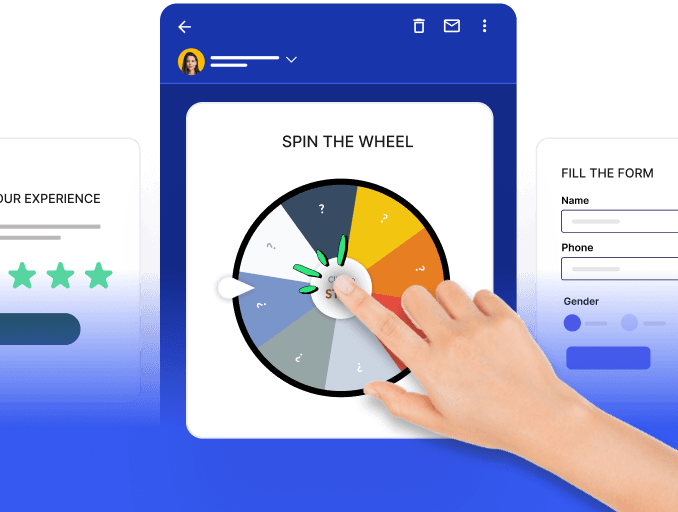The success of your email campaign is determined through inbox placement. On average, only 83% of emails make it to the inbox. But sometimes, emails may not even reach the recipient’s server. This means all your strategies, segmentations, and content efforts will be wasted if the email doesn’t reach the recipient.
Email deliverability is often confused with email delivery rate. So, through this guide, we will begin by defining the email delivery rate and present you with the best practices to improve your email delivery rate.
Table of contents
What is email delivery rate?
Email delivery rate is the percentage of emails accepted by the recipient's servers without allowing bounces to occur. This process begins when you hit send, as it’s the communication between the sending and receiving servers since the receiving server thinks about whether or not to receive the message.
It is an accurate metric as it quantifies the number of emails that reached the recipient minus the few bounces. But it only tells you a little about where they have landed, either the inbox or the spam folder.
Why is email delivery rate important?
It is important to make sure that your emails get delivered successfully.Without delivery, what is the purpose of sending an email?
This ensures that your message is delivered, as well as helping to maintain a positive IP reputation.
This tarnishes your sender’s reputation, leading emails to get continuously flagged as spam and ending in spam folders. As a result, your future campaigns will be less likely to be delivered.
Email deliverability vs. Email delivery rate
The terms deliverability and delivery rate are often used interchangeably. Nonetheless, it's crucial to recognize the distinction in its functionality to ensure the success of an email marketing campaign.
Email delivery refers to whether the recipient’s server receives your email. Using this metric, we can determine what percentage of emails did not bounce.
Email deliverability is inbox placement, ensuring that emails are successfully delivered to the recipient's inbox rather than ending up in their spam folder. This second half of the email journey focuses on measuring the number of emails that reach the primary tab of the recipient's inbox, indicating their successful delivery and proper placement.
It’’s possible to have a high delivery rate and poor deliverability. The delivery rate is quite accurate, while deliverability is pretty much an educated guess based on the trends of the metrics over time.
Formulas to measure email delivery rate and email deliverability
- Email Delivery rate = [( No of mails sent - No of bounces) / No of email sent ]*100
The delivery rate measures the emails successfully delivered to the recipient's server. In contrast, the bounce rate determines the no of emails that weren’t accepted by the inbox and were returned to the sender. Bounce rates that are less than 2% are considered to be good, since they don't significantly affect campaign effectiveness.
- Email deliverability = ( No of emails delivered to the recipient's inbox)/(No of emails sent)
As deliverability refers to emails that land in the inbox while the rest land in spam, promotion, or social, which recipients rarely check.
💡Related guide: Everything You Need to Know About Email Deliverability
Yes, Your email has bounced. Bounces is the number of emails the recipient’s server rejected for various reasons. Bounces are two types:
Hard bounces result from permanent issues like invalid email addresses or non-existent domain names. This frequently happens when users utilize temporary or fake email addresses.
Soft bounces are typically caused by temporary reasons, such as problems with the recipient's server or a full inbox.
Once the bounce happens, the recipient’s server promptly sends you an automated message - Non-Delivery report . This gives you insights into why the bounce happened in the first place with respect to the delivery.
💡Related guide: All About Hard Bounce & Soft Bounce
You can calculate bounce Rate by, Email bounce rate = (no of bounced emails / total number of emails sent) * 100
Reasons for the bounce
The reasons for the bounces include temporary or permanent issues like
Wrong/inactive email addresses
Recipients full inbox
Recipient’s server is down.
Heavy email copy
Incorrect configuration of recipient’s mailbox
Now that we know that bounce rates cause delivery rates to tank, we must employ best practices to nip it in the bud.
Best practices for improving email delivery rate
When incorporated from the sender's end, best practices will increase the delivery rate, thereby reducing bounces.
Ensure clean list hygiene.
Preserving your email list is the key to minimizing bounce rates. Email decay is natural and poor-quality data has a massive impact on your marketing results. According to zero bounce, at least 23% of an email list degrades yearly. When this happens, emails bounce and are not delivered. To avoid this, implement these tips to help you clean your email list:
Start by identifying people who frequently engage with your email.
Sometimes, people must remember they subscribed to your email list due to busy work routines. In that case, send them one last email as a reminder and give them a choice of whether to continue/ unsubscribe. Through this, you will find the duplicates in your list.
Now, remove the duplicates, as sending emails to them will hinder your important mail metrics, risking your email to land in their spam folders.
Identify spam email addresses; simply remove addresses that look absurd. For example,
strawberrycupcake@gmail.com & apple@hotmail.com
- Email lists often come with typos. Correct obvious typos and make it right
Eg: maria@gamil.com to maria@gmail.com
💡Related guide: How to Verify & Clean Email List to Maintain Email Hygiene
Verify email addresses by setting up a double opt-in
By doing this, email marketers are protected against not only fake emails but also email addresses with spelling mistakes as well as those who are not interested in your emails.
This process not only creates more robust relationships with contacts, but also you will have solid proof to show that the recipient opted-in for this in the first place. Also, this guarantees only valid email addresses as they must click confirm from their email address. This reduces typos, hence fewer hard bounces and your sender's reputation isn’t tarnished.
Never purchase email lists.
Buying an email market list might not be hard on your pocket, but it’s not how you build a loyal email base. These lists are typically segmented based on job titles, industries, and relevant demographics for your business. Despite many vendors promising accurate data and high deliverability rates, buying email lists has significant consequences.
The email addresses within purchased lists often belong to users who did not willingly subscribe to your emails. Furthermore, many lists include outdated and inactive email addresses, resulting in higher bounce rates. Consequently, sending emails to these recipients can be viewed as intrusive, impacting your sender score.
Yes, building an organic list of email subscribers who are genuinely interested in your emails takes time. Instead of purchasing email lists, stick to building an organic list, as these subscribers wish to receive communications from you and will actively engage with your content.
Check your email verification tools for validity
Email addresses turn invalid or cease to function for various reasons. Some visible reasons include changes in behavior and technical glitches.
If you remove invalid and inactive email addresses, your emails will be accepted in recipients' inboxes. This reduces the chances of bounces and a bad sender reputation.
Your email list can be thoroughly scanned for invalid and inactive emails using various email verification tools.
Avoid large emails.
Do away with sending large emails, as it’s one of the main reasons to reject your emails.
Since when you hit send, your emails go through various mail transfer agents to reach the mailbox. Then, a large email may encounter delivery issues during this process, resulting in a bounce back. Different email service providers have various limitations on the size of emails they like to accept.
To minimize your bounce rate, knowing the acceptable file size is crucial to ensuring your messages reach the recipient's inbox.
Takeaways
It is email delivery rate that ensures email's deliverability. But high email delivery alone doesn’t ensure your campaign’s success. This asserts the fact one can’t exist without the other. To capture the second half of the email’s journey after accepting by the recipient’s email server. To ensure a successful email delivery, these best practices are essential.







